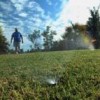 While a healthy lawn typically takes up and uses applied fertilizer for growth and protein production, nutrients may leach or run off into water bodies or groundwater when fertilizer is overapplied or applied to an unhealthy lawn. In an attempt to reduce this nonpoint source pollution, FDACS developed a rule to regulate the amount of N and P applied to lawns as fertilizer. The Urban Turf Fertilizer Rule regulates what can be sold and marketed as an urban turf fertilizer and requires specific wording on the fertilizer bag. This rule was enacted in response to concerns over potential pollution of water resources resulting from the nitrogen (N) and phosphorus (P) in these fertilizers. This 3-page fact sheet was written by Laurie E. Trenholm, and published by the UF Department of Environmental Horticulture, March 2013.
While a healthy lawn typically takes up and uses applied fertilizer for growth and protein production, nutrients may leach or run off into water bodies or groundwater when fertilizer is overapplied or applied to an unhealthy lawn. In an attempt to reduce this nonpoint source pollution, FDACS developed a rule to regulate the amount of N and P applied to lawns as fertilizer. The Urban Turf Fertilizer Rule regulates what can be sold and marketed as an urban turf fertilizer and requires specific wording on the fertilizer bag. This rule was enacted in response to concerns over potential pollution of water resources resulting from the nitrogen (N) and phosphorus (P) in these fertilizers. This 3-page fact sheet was written by Laurie E. Trenholm, and published by the UF Department of Environmental Horticulture, March 2013.
http://edis.ifas.ufl.edu/ep353
Category: Lawn & Garden
Whiteflies on Landscape Ornamentals (ENY317/MG254)
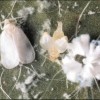 Whiteflies are common pests on many ornamental plants. Some of the most economically important species in Florida are the silverleaf whitefly, fig or ficus whitefly, citrus whitefly, and the rugose spiraling whitefly. The most frequently attacked plants include allamanda, avocado, chinaberry, citrus, fig, fringe tree, gardenia, gumbo limbo, ligustrum, mango, various palms, persimmon, viburnum, and many annuals. This 4-page fact sheet was written by E. A. Buss, and published by the UF Department of Entomology and Nematology, March 2013.
Whiteflies are common pests on many ornamental plants. Some of the most economically important species in Florida are the silverleaf whitefly, fig or ficus whitefly, citrus whitefly, and the rugose spiraling whitefly. The most frequently attacked plants include allamanda, avocado, chinaberry, citrus, fig, fringe tree, gardenia, gumbo limbo, ligustrum, mango, various palms, persimmon, viburnum, and many annuals. This 4-page fact sheet was written by E. A. Buss, and published by the UF Department of Entomology and Nematology, March 2013.
http://edis.ifas.ufl.edu/mg254
Bagworm, Thyridopteryx ephemeraeformis Haworth (Insecta: Lepidoptera: Psychidae) (EENY548/IN981)
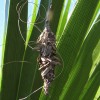 North American bagworm can feed on over 50 families of deciduous and evergreen trees and shrubs. Severe infestations can damage the aesthetics and health of host plants, especially juniper and arborvitae species. Many of the preferred host plants do not grow well below the USDA hardiness zone 8A, but due to its wide host range, high female fecundity, and method of dispersal, bagworm can still be problematic in the Florida landscape. This 5-page fact sheet was written by Brooke L. Moffis and Steven P. Arthurs, and published by the UF Department of Entomology and Nematology, March 2013.
North American bagworm can feed on over 50 families of deciduous and evergreen trees and shrubs. Severe infestations can damage the aesthetics and health of host plants, especially juniper and arborvitae species. Many of the preferred host plants do not grow well below the USDA hardiness zone 8A, but due to its wide host range, high female fecundity, and method of dispersal, bagworm can still be problematic in the Florida landscape. This 5-page fact sheet was written by Brooke L. Moffis and Steven P. Arthurs, and published by the UF Department of Entomology and Nematology, March 2013.
http://edis.ifas.ufl.edu/in981
Recommended Native Landscape Plants for Florida's Treasure Coast (ENH1082/EP348)
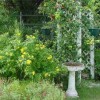 This 17-page fact sheet provides useful resources and handy tables for information on the function, form, and landscape use of proven native performers of the Florida Treasure Coast (Martin, St. Lucie, and Indian River Counties). Written by Sandra B. Wilson, Judith A. Gersony, Keona L. Nolan, Janice C. Broda, and Edward A. Skvarch, Jr., and published by the UF Department of Environmental Horticulture, March 2013.
This 17-page fact sheet provides useful resources and handy tables for information on the function, form, and landscape use of proven native performers of the Florida Treasure Coast (Martin, St. Lucie, and Indian River Counties). Written by Sandra B. Wilson, Judith A. Gersony, Keona L. Nolan, Janice C. Broda, and Edward A. Skvarch, Jr., and published by the UF Department of Environmental Horticulture, March 2013.
http://edis.ifas.ufl.edu/ep348
Developing Urban Community Garden Projects (WC139)
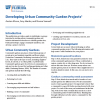 Community gardens are pieces of land where groups of people grow and maintain vegetable and flower plants. They exist in all types of areas, including neighborhoods, at schools, or on other public or private lands. Community gardens grow food for local consumption or sale and can also be used for teaching gardening and other skills This 7-page fact sheet provides a guide to individuals or groups interested in starting urban community gardens and includes information about how to identify garden sites, build partnerships, engage community members, and develop a project overview. Written by Austen Moore, Amy Harder, and Norma Samuel, and published by the UF Department of Agricultural Education and Communication, March 2013.
Community gardens are pieces of land where groups of people grow and maintain vegetable and flower plants. They exist in all types of areas, including neighborhoods, at schools, or on other public or private lands. Community gardens grow food for local consumption or sale and can also be used for teaching gardening and other skills This 7-page fact sheet provides a guide to individuals or groups interested in starting urban community gardens and includes information about how to identify garden sites, build partnerships, engage community members, and develop a project overview. Written by Austen Moore, Amy Harder, and Norma Samuel, and published by the UF Department of Agricultural Education and Communication, March 2013.
http://edis.ifas.ufl.edu/wc139
Enemigos naturales y control biologico (ENY866/IN977)
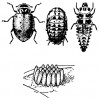 Hay muchos insectos benéficos pero solamente hay algunos que son enemigos naturales de plagas. Los enemigos naturales más comunes de encontrar son: mariquitas/tortolitas, crisopas, antocóridos (Orius), ligaéidos, sírfidos, avispas de agallas, hormigas, avispas parasíticas, moscas parasíticas y ácaros depredadores. La importancia relativa varía de acuerdo con cada insecto plaga, el hábitat y la estación o época del año. This 7-page fact sheet was written by Hugh A. Smith y John L. Capinera, traducido por Ana Lucrecia MacVean, and published by the UF Department of Entomology and Nematology, January 2013.
Hay muchos insectos benéficos pero solamente hay algunos que son enemigos naturales de plagas. Los enemigos naturales más comunes de encontrar son: mariquitas/tortolitas, crisopas, antocóridos (Orius), ligaéidos, sírfidos, avispas de agallas, hormigas, avispas parasíticas, moscas parasíticas y ácaros depredadores. La importancia relativa varía de acuerdo con cada insecto plaga, el hábitat y la estación o época del año. This 7-page fact sheet was written by Hugh A. Smith y John L. Capinera, traducido por Ana Lucrecia MacVean, and published by the UF Department of Entomology and Nematology, January 2013.
http://edis.ifas.ufl.edu/in977
Air Potato Leaf Beetle (Suggested Common Name), Lilioceris cheni Gressitt and Kimoto (Insecta: Coleoptera: Chrysomelidae: Criocerinae) (EENY547/IN972)
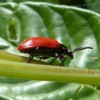 This leaf feeding beetle was recently introduced into Florida from China for biological control of air potato. This 4-page fact sheet provides information on the distribution, appearance, life cycle, host range and importance of the beetle. Written by Entomology and Nematology, and published by the UF Department of Ted D. Center and William A. Overholt, January 2013.
This leaf feeding beetle was recently introduced into Florida from China for biological control of air potato. This 4-page fact sheet provides information on the distribution, appearance, life cycle, host range and importance of the beetle. Written by Entomology and Nematology, and published by the UF Department of Ted D. Center and William A. Overholt, January 2013.
http://edis.ifas.ufl.edu/in972
Calonectria (Cylindrocladium) Leaf Spot of Palm (PP302)
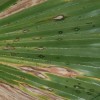 Calonectria is a fungus that affects a large number of hosts worldwide, including timber and ornamental, agricultural, and horticultural crops, causing a wide range of disease symptoms, such as cutting rot, damping-off of seedlings, leaf spot, shoot blight, and root rot. This 4-page fact sheet was written by Jiaming Yu and Monica L. Elliott, and published by the UF Department of Plant Pathology, January 2013.
Calonectria is a fungus that affects a large number of hosts worldwide, including timber and ornamental, agricultural, and horticultural crops, causing a wide range of disease symptoms, such as cutting rot, damping-off of seedlings, leaf spot, shoot blight, and root rot. This 4-page fact sheet was written by Jiaming Yu and Monica L. Elliott, and published by the UF Department of Plant Pathology, January 2013.
http://edis.ifas.ufl.edu/pp302
Ornamental Palms for Central Florida (ENH60/EP020)
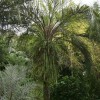 Palms are often thought of as symbols of the tropics, but fortunately there are a number of palm species that grow in warm, temperate climates, such as that of Central Florida. This 8-page fact sheet was written by Timothy K. Broschat and James E. Davis, and published by the UF Department of Environmental Horticulture, January 2013.
Palms are often thought of as symbols of the tropics, but fortunately there are a number of palm species that grow in warm, temperate climates, such as that of Central Florida. This 8-page fact sheet was written by Timothy K. Broschat and James E. Davis, and published by the UF Department of Environmental Horticulture, January 2013.
http://edis.ifas.ufl.edu/ep020
Puss Caterpillar (Larva), Southern Flannel Moth (Adult), Megalopyge opercularis (J. E. Smith 1797) (Insecta: Lepidoptera: Zygaenoidea: Megalopygidae) (EENY545/IN976)
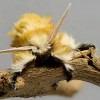 The southern flannel moth is an attractive small moth that is best-known because of its larva, the puss caterpillar, which is one of the most venomous caterpillars in the United States. This 12-page fact sheet was written by Donald W. Hall, and published by the UF Department of Entomology and Nematology, January 2013.
The southern flannel moth is an attractive small moth that is best-known because of its larva, the puss caterpillar, which is one of the most venomous caterpillars in the United States. This 12-page fact sheet was written by Donald W. Hall, and published by the UF Department of Entomology and Nematology, January 2013.
http://edis.ifas.ufl.edu/in976
Amaryllis Lesion Nematode, Pratylenchus hippeastri Inserra et al., 2006 (Nematoda: Tylenchida: Pratylenchidae) (EENY546/IN975)
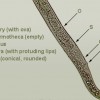 Amaryllis lesion nematode is an important nematode pest of amaryllis in Florida. It reduces plant vigor, flower yield, and bulb size. As the nematodes tunnel through the root, the damaged cells die and collapse, forming lesions on the exterior and the interior of the root tissue. This 4-page fact sheet was written by William T. Crow, and published by the UF Department of Entomology and Nematology, January 2013.
Amaryllis lesion nematode is an important nematode pest of amaryllis in Florida. It reduces plant vigor, flower yield, and bulb size. As the nematodes tunnel through the root, the damaged cells die and collapse, forming lesions on the exterior and the interior of the root tissue. This 4-page fact sheet was written by William T. Crow, and published by the UF Department of Entomology and Nematology, January 2013.
http://edis.ifas.ufl.edu/in975
Design and Implementation of Edible Plant Demonstration Gardens: A Case Study of the Putnam County Extension Edible Garden (ENH1205/EP466)
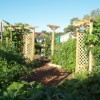 Demonstration gardens are a collection of plants assembled and organized in a manner that allows garden visitors to access and study them. Most gardens are designed with a particular focus and include plants that support the purpose and educational theme of the garden. This case study features an edible plant demonstration garden that was designed and installed in Hastings, Florida, on the Extension office grounds. The UF/IFAS program and the Partnership for Water, Agriculture, and Community Sustainability (FPWACS) designed and implemented the demonstration garden using a step-by-step process that is discussed in this 15-page fact sheet written by Gail Hansen, Joseph Sewards, Rebecca Almeida, and Andrew Dunn, and published by the UF Department of Environmental Horticulture, November 2012.
Demonstration gardens are a collection of plants assembled and organized in a manner that allows garden visitors to access and study them. Most gardens are designed with a particular focus and include plants that support the purpose and educational theme of the garden. This case study features an edible plant demonstration garden that was designed and installed in Hastings, Florida, on the Extension office grounds. The UF/IFAS program and the Partnership for Water, Agriculture, and Community Sustainability (FPWACS) designed and implemented the demonstration garden using a step-by-step process that is discussed in this 15-page fact sheet written by Gail Hansen, Joseph Sewards, Rebecca Almeida, and Andrew Dunn, and published by the UF Department of Environmental Horticulture, November 2012.
http://edis.ifas.ufl.edu/ep466
Tropical sod webworm Herpetogramma phaeopteralis Guenee (Insecta: Lepidoptera: Crambidae) (EENY541/IN968)
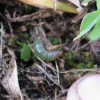 Tropical sod webworm larvae are destructive pests of warm season turfgrasses in the southeastern U.S., especially on newly established sod, lawns, athletic fields, and golf courses. Larval feeding damage reduces turfgrass aesthetics, vigor, photosynthesis and density. The first sign of damage is often caused by differences in grass height in areas where larvae are feeding. This 5-page fact sheet was written by Nastaran Tofangsazie, Steven P. Arthurs, and Ronald Cherry, and published by the UF Department of Entomology and Nematology, November 2012.
Tropical sod webworm larvae are destructive pests of warm season turfgrasses in the southeastern U.S., especially on newly established sod, lawns, athletic fields, and golf courses. Larval feeding damage reduces turfgrass aesthetics, vigor, photosynthesis and density. The first sign of damage is often caused by differences in grass height in areas where larvae are feeding. This 5-page fact sheet was written by Nastaran Tofangsazie, Steven P. Arthurs, and Ronald Cherry, and published by the UF Department of Entomology and Nematology, November 2012.
http://edis.ifas.ufl.edu/in968
How to Use Deterrents to Stop Damage Caused by Nuisance Wildlife in Your Yard (WEC326/UW371)
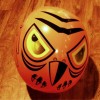 Many of us try to attract particular types of wildlife to our yards so that we can observe them. We often select plants and other materials that we know provide food, cover, and water for those animals we like to watch. However, when unwanted wildlife visit your yard and cause damage, you might need to consider the use of tactics that could deter these unwanted species. This 8-page fact sheet was written by Holly K. Ober and Arlo Kane, and published by the UF Department of Wildlife Ecology and Conservation, October 2012.
Many of us try to attract particular types of wildlife to our yards so that we can observe them. We often select plants and other materials that we know provide food, cover, and water for those animals we like to watch. However, when unwanted wildlife visit your yard and cause damage, you might need to consider the use of tactics that could deter these unwanted species. This 8-page fact sheet was written by Holly K. Ober and Arlo Kane, and published by the UF Department of Wildlife Ecology and Conservation, October 2012.
http://edis.ifas.ufl.edu/uw371
How To Identify the Wildlife Species Responsible for Damage in Your Yard (WEC324/UW369)
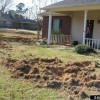 Although many homeowners enjoy wildlife in their yards, there are situations where wildlife can become a nuisance. In some circumstances, wild animals can cause extensive damage to lawns and gardens. Learning to identify which species is responsible for this damage is the first step in finding a solution to the problem. This 6-page fact sheet provides images of wildlife damage in residential settings to help you determine which species may be causing similar problems in your yard. Written by Holly K. Ober and Arlo Kane, and published by the UF Department of Wildlife Ecology and Conservation, October 2012.
Although many homeowners enjoy wildlife in their yards, there are situations where wildlife can become a nuisance. In some circumstances, wild animals can cause extensive damage to lawns and gardens. Learning to identify which species is responsible for this damage is the first step in finding a solution to the problem. This 6-page fact sheet provides images of wildlife damage in residential settings to help you determine which species may be causing similar problems in your yard. Written by Holly K. Ober and Arlo Kane, and published by the UF Department of Wildlife Ecology and Conservation, October 2012.
http://edis.ifas.ufl.edu/uw369
Overview of How to Stop Damage Caused by Nuisance Wildlife in Your Yard (WEC323/UW368)
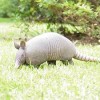 In Florida, we are fortunate to have a wide variety of wildlife to watch and enjoy. Indeed, many homeowners attempt to attract particular types of wildlife to their yards to watch. However, wild animals can become a nuisance in some situations. This 4-page fact sheet is the first in a five-part series describing tactics you can use to cope with wildlife that have become a nuisance. Here we suggest a sequence of steps you can implement when wildlife are causing damage in your yard. These suggestions should help reduce wildlife damage in a practical, humane, and environmentally responsible manner. Written by Holly K. Ober and Arlo Kane, and published by the UF Department of Wildlife Ecology and Conservation, October 2012.
In Florida, we are fortunate to have a wide variety of wildlife to watch and enjoy. Indeed, many homeowners attempt to attract particular types of wildlife to their yards to watch. However, wild animals can become a nuisance in some situations. This 4-page fact sheet is the first in a five-part series describing tactics you can use to cope with wildlife that have become a nuisance. Here we suggest a sequence of steps you can implement when wildlife are causing damage in your yard. These suggestions should help reduce wildlife damage in a practical, humane, and environmentally responsible manner. Written by Holly K. Ober and Arlo Kane, and published by the UF Department of Wildlife Ecology and Conservation, October 2012.
http://edis.ifas.ufl.edu/uw368
How to Modify Habitat to Discourage Nuisance Wildlife in Your Yard (WEC325/UW370)
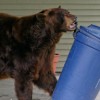 Although often overlooked, habitat modification is the cheapest and most effective long-term solution to nuisance wildlife problems in residential landscapes. Removing the resources wildlife are seeking when they visit your yard can be a much more cost-effective solution than restricting access to those resources with physical barriers, scaring wildlife with hazing tactics, deterring wildlife with repellents, or removing wildlife by trapping or killing nuisance animals. This 3-page fact sheet was written by Holly K. Ober and Arlo Kane, and published by the UF Department of Wildlife Ecology and Conservation, October 2012.
Although often overlooked, habitat modification is the cheapest and most effective long-term solution to nuisance wildlife problems in residential landscapes. Removing the resources wildlife are seeking when they visit your yard can be a much more cost-effective solution than restricting access to those resources with physical barriers, scaring wildlife with hazing tactics, deterring wildlife with repellents, or removing wildlife by trapping or killing nuisance animals. This 3-page fact sheet was written by Holly K. Ober and Arlo Kane, and published by the UF Department of Wildlife Ecology and Conservation, October 2012.
http://edis.ifas.ufl.edu/uw370
How to Use Traps to Catch Nuisance Wildlife in Your Yard (WEC327/UW372)
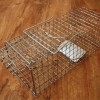 When wildlife become a nuisance in your yard, there are three general approaches you can take: make habitat modifications, use deterrents, or trap animals. In most residential settings, making habitat modifications or using deterrents will be both simpler and more effective than trapping. But trapping is warranted in certain situations when trying to solve conflicts between people and wildlife. This 6-page fact sheet provides information on stopping wildlife damage through the use of trapping. Written by Holly K. Ober and Arlo Kane, and published by the UF Department of Wildlife Ecology and Conservation, October 2012.
When wildlife become a nuisance in your yard, there are three general approaches you can take: make habitat modifications, use deterrents, or trap animals. In most residential settings, making habitat modifications or using deterrents will be both simpler and more effective than trapping. But trapping is warranted in certain situations when trying to solve conflicts between people and wildlife. This 6-page fact sheet provides information on stopping wildlife damage through the use of trapping. Written by Holly K. Ober and Arlo Kane, and published by the UF Department of Wildlife Ecology and Conservation, October 2012.
http://edis.ifas.ufl.edu/uw372
Pyrus communis, Common Pear (FOR293/FR361)
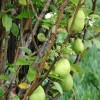 The showy flowers and manageable height of common pear makes it a favorable ornamental landscape tree. Some find the aromatic flowers and sweet edible fruits to be an additional plus; however, a pollinator specimen must be nearby in order for the female tree to produce fruit. Careful consideration should be taken when choosing a planting location, since the soft fruits can be messy if not harvested. This 2-page fact sheet was written by Michael G. Andreu, Melissa H. Friedman, and Robert J. Northrop, and published by the UF Department of School of Forest Resources and Conservation, July 2012.
The showy flowers and manageable height of common pear makes it a favorable ornamental landscape tree. Some find the aromatic flowers and sweet edible fruits to be an additional plus; however, a pollinator specimen must be nearby in order for the female tree to produce fruit. Careful consideration should be taken when choosing a planting location, since the soft fruits can be messy if not harvested. This 2-page fact sheet was written by Michael G. Andreu, Melissa H. Friedman, and Robert J. Northrop, and published by the UF Department of School of Forest Resources and Conservation, July 2012.
http://edis.ifas.ufl.edu/fr361
Casuarina equisetifolia, Australian Pine (FOR298/FR366)
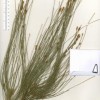 Australian pine was originally planted in Florida in the late 1800’s as a windbreak and for shade. But soon thereafter it was spreading without help from humans. Today it is considered a category I invasive species in Florida, and the Division of Plant Industry strictly prohibits possessing, transporting, and cultivating this species. For those who find this tree in close proximity to their home, it’s a good idea to replace it since Australian pine is known to have a very low resistance to wind. Australian pine is commonly found growing on coastal shorelines since it thrives in salty, sandy environments. This 2-page fact sheet was written by Michael G. Andreu, Melissa H. Friedman, and Robert J. Northrop, and published by the UF Department of School of Forest Resources and Conservation, July 2012.
Australian pine was originally planted in Florida in the late 1800’s as a windbreak and for shade. But soon thereafter it was spreading without help from humans. Today it is considered a category I invasive species in Florida, and the Division of Plant Industry strictly prohibits possessing, transporting, and cultivating this species. For those who find this tree in close proximity to their home, it’s a good idea to replace it since Australian pine is known to have a very low resistance to wind. Australian pine is commonly found growing on coastal shorelines since it thrives in salty, sandy environments. This 2-page fact sheet was written by Michael G. Andreu, Melissa H. Friedman, and Robert J. Northrop, and published by the UF Department of School of Forest Resources and Conservation, July 2012.
http://edis.ifas.ufl.edu/fr366